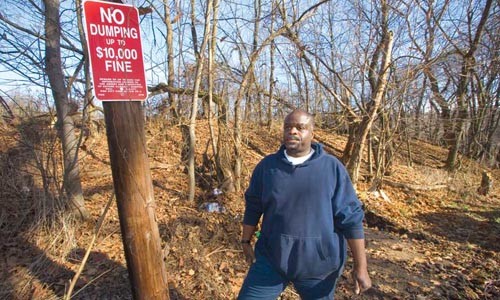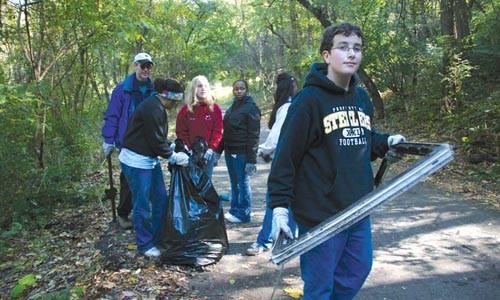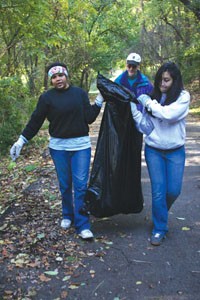At first glance, you might almost be looking at the wreckage of a tornado-toppled home. Flattened cabinets. The remains of a wooden ladder. Rolls of worn-out carpeting. A cracked toilet, even. All of it lies scattered off Colombo Street in Garfield Heights. And all of it planted there not by nature, but by man.
It's the handiwork of a small-time contractor or independent hauler getting rid of household waste, concludes Danielle Crumrine.
"They come in and clean out the basement for you," says Crumrine, a board member of PA CleanWays of Allegheny County, the local chapter of a statewide advocacy group that targets dumping and littering. "And they dump it." The contractors advertise clean-up jobs for small fees, she says, which they can charge only because they get rid of waste the cheap way -- by trucking it into city neighborhoods and doing a quick job of unloading in the dark of night.
The people most likely to be dumped on, meanwhile, are those living in neighborhoods like Garfield. According to surveys and analyses conducted by PA CleanWays, residents in these areas are usually victimized by outsiders: Contractors or haulers who scrimp on disposal fees have created their own network of illegal dumpsites, which dot vacant lots and wooded hillsides in some of the city's poorest neighborhoods.
For the past few years, Crumrine has been playing Sherlock Holmes at local dumping grounds, where refuse ranges from construction material to the everyday contents of a trashcan. Just up the hill from Colombo, on Edlam Street, for example, a five-yard trail of soda cans, bottles and aluminum-foil bags lies strewn amid the maple and locust trees.
"This is an anthropological study in waiting," says Crumrine, examining what may well be the detritus of an after-school party of teen-agers.
Some residents argue that the negative impact of unrelenting, pervasive dumping, especially on underprivileged neighborhoods, transcends the unsightly trash itself.
"When you see that from an early age, it becomes the norm," says Will Thompkins, director of community outreach with The Pittsburgh Project, a community-service organization based in the North Side. All year round, Thompkins organizes cadres of volunteers, many of them teen-agers, to haul trash out of the surrounding dumpsites. The cleanups not only beautify the community but also build the right attitude. Keeping the environment clean takes "a mindset," Thompkins says.
To create that mindset, Crumrine has been training community activists to fight dumping.
Since Pittsburgh kicked off the "Redd Up" campaign earlier this year, residents in trash-plagued neighborhoods have seen their efforts buoyed by the city. They've even managed to wipe out some of the dumpsites -- at least for now. But the people who dump there are still at large. There are myriad state and local ordinances prohibiting illegal dumping and several agencies wielding enforcement authority, but most violators still manage to elude detection. Last summer, a Butler man was charged by the state for dumping 10,000 tires in Butler and Lawrence counties. But neighborhood cleanups regularly turn up a dozen or more tires on a single site, and no one is held accountable for these smaller-scale dumps.
You might expect dumpers to find remote parts of the city to ditch their trash. But while there is a discernible pattern to dumping, it's more socio-economic than geographic.
Of the 340 Allegheny County dumpsites identified in 2005 by PA CleanWays, some were out of the way, but most were in plain sight. Dumpers, it seems, don't care about whether their trash is visible: They only care about who has to see it.
Rikki Hrenko, the group's intern and a master's candidate at Carnegie Mellon University's Heinz School of Public Policy and Management, studied the demographics of the neighborhoods where most dumpsites are located.
Using data from the Census Bureau, Hrenko determined where dumpsites are most likely to be found: near concentrations of the unemployed; in neighborhoods where a high percentage of residents lack a high school diploma; or where household incomes are below $40,000.

For example, in census tracts where at least 10 percent of the population age 16 or above was unemployed, Hrenko found an average of eight dumps. By comparison, there were almost never any dumps in tracts where only 5 percent of working-age adults were unemployed.
Hrenko also found that dumpsites were often clustered around predominantly African-American neighborhoods, such as Homewood and Perry Hilltop. That isn't always the case, she notes: Dumping sites in the West End, for example, don't necessarily conform to the broader trend. And all in all, "I think it is important to note that it would be naive to look at factors singly," says Hrenko in an e-mail response from Estonia, where she now works as an environmental specialist. "In reality it is the mixture of these factors together that is important to consider."
Still, Hrenko's numbers give substance to the anecdotal evidence from those out in the streets.
"I'm out in the field. I observe these inequities. I observe these trends," says Crumrine.
So does Mark Brentley.
Brentley, a Pittsburgh Public Schools board member who lives in Perry Hilltop, knows most of the dumping hotspots in the North Side -- the nooks, the blind alleyways and the slopes carved by serpentine streets in this hilly terrain. And he worries that, in a neighborhood where recreational amenities are lacking, dumpsites close to where children congregate can become unsavory playgrounds.
Take for example, the dumping hotspot near the Columbus Middle School. Off Brighton Road and near the entrance to the school, Irwin Avenue has long been a favorite for illegal dumpers. While the school was open, volunteers from PA CleanWays and the neighborhood stepped up to clear the dumps, lest schoolchildren be tempted to play there. Now that the school is closed, mound after mound of slag, mixed with red bricks, has been piling up nearby. Tires, fragments of dismembered furniture and piles of plywood strips are also scattered about.
"Maybe someone's digging up a foundation," says Brentley, examining the site.
Brentley isn't only a concerned resident who is tired of living around dumps; he also works as a laborer for the city's Department of Public Works, part of a crew dispatched to clean up the North Side regularly.
Dumping "is a two-pronged issue for me," he says. And no two dumps are the same.
Besides the run-of-the-mill items such as tires and construction and demolition waste, Brentley has had some nasty surprises. On a recent cleanup job, he came upon a box holding a dead pit bull. Judging from the numerous lacerations on the dog's body, Brentley guessed it was killed in an organized dogfight.
"It was a terrible sight," he recalls.
Less disturbing, but just as surprising, are the abandoned boats and cars that Brentley's crew sometimes finds. Tires, Brentley says, are always hot items. Those that dot neighborhood streets are sometimes used by children in an urbanized version of horseshoes.
There's no shortage of equipment to play with. On Gershon Street near the Northview Heights housing project, a trail of tires stretches for nearly half a mile, seemingly forming a rubber shoulder along the guardrail. And along a desolate stretch of Murzell Avenue nearby, Miesha Blackwell, 11, must step over tires and other trash every day on her way home after being dropped off by a school bus.
"It's messing up our community," Blackwell said on a recent walk home.
And then there are the more spectacular and jarring sites. On a precipice overlooking I-279 in Spring Hill, tires, ripped canvas, pieces of what looks like a dresser, a row of seats from a van and a variety of other discarded items, are lodged on bald branches of the hillside's trees.
"Why do these folks feel so comfortable doing it here?" asks Brentley. "Because these parts have been ignored by the city. The stuff lays here for so long. If it were dumped like this in Squirrel Hill, you'd have a crew out within 48 hours, tripping over each other to clean up."
More neighborhoods are receiving that kind of attention, says Guy Costa, director of the city's Public Works department. In recent months, public-works crews have fanned out to haul away debris from dumpsites in various neighborhoods -- all part of a citywide "Redd Up Pittsburgh" beautification campaign launched last spring by late Mayor Bob O'Connor.
"We concentrated on some of the worst areas of the city," says Costa.
Take Homewood's Tioga Street, where a huge lot across from the Helen Faison School primary campus was choked with bricks and concrete. Concerns about the site were raised by school personnel and neighborhood residents alike. The dumpsite along Tioga Street, and those located nearby, made the school feel less than safe. And O'Connor had recently struck a partnership with schools Superintendent Mark Roosevelt to establish "safety zones" within 1,000 feet of public school buildings.
Throughout Homewood, says Costa, city crews found more dumpsites the closer they got to the community's borders with neighboring Penn Hills and Wilkinsburg.
"It's like they come over the city line and dump," says Costa.
So the Public Works department got the marching orders. "We just went in to blitz it," says Costa. His "Redd Up" crew cleared hundreds of lots and hauled off tons of debris from Homewood, he says, and made similar efforts in Beltzhoover and Lawrenceville.
Of course, residents in many other neighborhoods think they have problems as bad or worse. But it can take some effort to get the city's attention.
"We help communities that want help," Costa adds. "We're seeing more community groups wanting to get involved." In order to keep the redd-up neighborhoods clean, residents have to not only help pick up the trash but also report on illegal dumpers, he says.
The problem isn't a lack of laws. Dumping is prohibited by state codes and local ordinances, which generally require a permit to dispose of waste. In fact, as many as seven government agencies have authority to police illegal dumping. At the state level, the Department of Environmental Protection (DEP) shares jurisdiction over dumping with the Department of Conservation and Natural Resources, the Fish and Boat Commission, the Game Commission and the state police. Closer to home, Allegheny County Health Department inspectors respond to dumping complaints by holding property owners responsible for removing the waste. Pittsburgh police, meanwhile, can charge violators with scattering rubbish.
But while numerous government agencies can enforce anti-dumping laws, few of them have the time to do so. "We have trouble trying to catch these people in the act," acknowledges DEP's Betsy Mallison.
County health department officials say they will investigate all complaints about dumping but they don't have the manpower to catch any violator in action.
"We're not out there looking for illegal dumpsites, because of staffing shortages," says Geoff Butia, who heads the solid-waste-management section of the county health department. "We just don't have the staff to do that anymore."
City police, meanwhile, have issued far fewer citations for scattering rubbish. Fifty have been issued this year so far, compared to nearly three times that many -- 149 -- in 2004.
"There is only a small fraction of society that illegally dumps," says Shannon Reiter, executive director of PA CleanWays. But, she adds, "If there's no fear of getting caught, they'll continue to dump. ... One of the most challenging things is to coordinate those enforcement efforts and competing resources." While agencies are sincere about wanting to address the problem, she says, "The resources aren't there to do enforcement."
Many agree that this is precisely the problem. Crumrine, formerly executive director of the county chapter of PA CleanWays, says the concentration of illegal dumpsites smacks of discrimination. The sites proliferate in poor, minority neighborhoods, she says, and that fact is partly enabled by "people who have the power to enforce the law [but] are not enforcing it."
Over the past two decades, activists have increasingly viewed such problems through the lens of what they call "environmental justice." They contend that legal and illegal dumps alike are more likely to be sited near minority neighborhoods -- and that such communities face escalated health and environmental risks as a result.
"It doesn't matter how [waste] gets there. It always ends up in low-income communities or communities of color," says Lois Gibbs, founder and executive director of the Center for Health, Environment & Justice in Falls Church, Va. For environmental-justice activists, the question is, "Here you have a vulnerable population that is subject to the nasty stuff: How do we deal with it in a fair and equitable way?"
For the most part, Gibbs and others have focused on challenging waste facilities that are legal. Grass-roots movements have sprouted around the country to halt waste incinerators and other environmental hazards that tend to plague poor or minority neighborhoods. These days, for example, Gibbs is busy helping to organize residents in East Liverpool, Ohio, 40 miles from Pittsburgh, to shut down a hazardous-waste incinerator.
But some have argued that the principles of environmental justice should also apply to illegal dumping grounds: States may not issue permits for such sites, they say, but a failure to enforce the law allows them to fester. Crumline originally commissioned the survey of Pittsburgh dumping grounds, in fact, to see whether the pattern of illegal dumping suggested a broader pattern of discrimination.
Still, the envelope can be pushed only so far. As Hrenko concluded in her analysis of dumping sites, "in order for a case of environmental justice to be made, the discrimination must be intentional, meaning [it can be] be traced back to a specific individual and policy."
In any case, says Gibbs, challenging illegal dumpsites poses the same problems as opposing legal waste-treatment plants. It's hard for poor communities to fight environmental hazards, Gibbs says, because residents there "feel powerless ... because society sort of convinces them of that.
"For the most part, folks in those neighborhoods," Gibbs adds, "if they're organized, they're organized around health care, adequate housing, feeding the hungry -- these are the immediate issues."
Short of challenging government agencies in court, Reiter is planning a summit with them in hopes of encouraging greater coordination. PA CleanWays has also been advocating using hidden cameras to catch illegal dumpers, the topic of a state summit slated for this week.
Such programs have proven effective in the coal regions in Northumberland County, where surveillance cameras posted at dumpsites have captured the license plates of offenders' vehicles. In September, a camera in Luzerne County snapped footage of a pickup truck unloading a tire, an old heater, and construction and demolition waste off a roadway. The driver was prosecuted. The cameras are part of an anti-dumping program launched by DEP two years ago in Northumberland and Columbia counties. Called Clean Up Our Anthracite Lands and Streams (COALS), the program was born of a partnership between government agencies, the coal industry and environmental groups trying to curb dumping.
The city is also looking into installing surveillance cameras at some of more notorious spots, including a tire dumping ground in Hazelwood.
In the meantime, as county Health Department spokesman Guillermo Cole puts it: "We have to rely on the public to bring [dumpsites] to our attention."
Mary Savage's first cleanup job came 30 years ago, when she dragged a refrigerator and a mattress from a vacant lot near the Carnegie Library in Homewood, where she was working as a community program specialist. She's been picking up trash ever since -- often on her own.
"In this neighborhood, [dumpers] would come in trucks at night," says the Homewood resident.
Besides battling the nocturnal violators, Savage had fought the apathy that pervaded her community. Sometimes when she was picking up a vacant lot, a few passersby might join in. But many others, especially those too young to remember a time when Homewood wasn't being dumped on, shrugged off her efforts as quixotic. "They felt that this is it," Savage recalled.
These days, however, when Savage surveys the neighborhood, she nods approvingly at the vacant lots free of castaways and shorn of weeds and tall grass. Some parcels have even been converted into community gardens adorned with shrubs and benches. There are a few debris-choked spots down certain alleyways, but even there, a nearby Dumpster suggests the problem is under control.
"There is still a lot of work to be done," says Savage, who even in her 70s is not about to slow down -- especially now that cleanup efforts in Homewood are on a roll.
Back in spring, when the city's "Redd Up" campaign began, Savage and a few other neighborhood activists couldn't wait to get a hand.
"We were at the point that we were ready," says Savage.
City crews swooped in and did the heavy lifting. They removed the hefty items and waste that was already bundled up, and they knocked down abandoned buildings that can serve as dens for dumps. Once residents saw that their neighborhood could indeed be rid of dumps, many started pitching in. Some were even organized into block groups to monitor illegal dumping nearby.
"The Redd Up campaign jump-started everything," says Crumrine, who has since been training residents from Homewood and other neighborhoods to organize community cleanups. "There were already people doing that kind of work. But what keeps people from getting involved is a feeling of hopelessness -- a feeling that they individually can't make a difference. They felt the problem was too big for them. The 'Redd Up' [campaign] really poked through that."
Although there is evidence that violators tend not to dump on a cleaned-up lot, in order to deter future dumping, residents will have to keep up with the maintenance of the lots.
"There should be an effort that they be maintained," says Savage. "Otherwise it'll revert right back." She and other Homewood residents involved in cleanups hope that part of the recently announced city budget earmarked for "Redd Up" efforts -- as much as $500,000 -- will be spent maintaining the sites.
Public education about how to dispose of unwanted items is also important. While there is a contingent of hardcore scofflaws, many people dump out of ignorance about the right way of doing things. Even Crumrine says that when she was recently faced with disposing of an old washer and dryer, she had no idea how to get rid of such appliances properly. "It's a lot of work trying to figure out what to do," says Crumrine.
That kind of education can't be accomplished in a vacuum, especially in low-income urban neighborhoods where families are confronted with more pressing issues. To engage residents in anti-dumping efforts, PA Cleanways has adopted a national model called Method to Engage Residents and Grassroots in the Environment (MERGE). The idea is to survey residents about their priorities and tie them to environmental concerns. A model for the program, designed by Urban Ecology Collaborative, is being tested in five other cities: Boston, New York, New Haven, Baltimore and Washington, D.C.
In any case, preventing dumping takes both concerted and consistent effort. Homewood's Savage, for one, says she's determined to stick it out for the long haul.
"We want it to be maintained," says Savage. "Even though it is a deprived neighborhood, it doesn't have to look deprived."




















